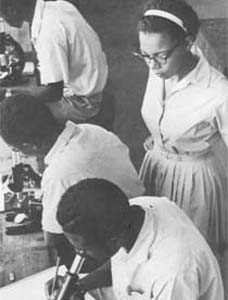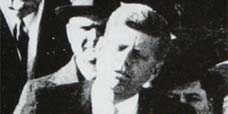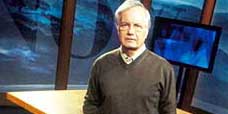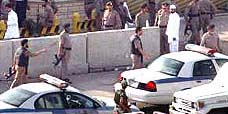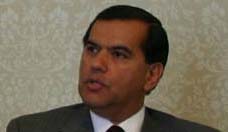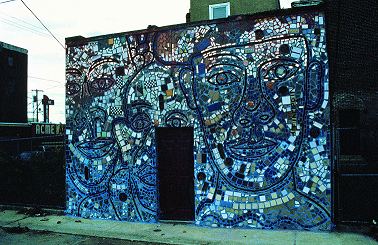
After three years in Peru doing craft development work for the Peace Corps, Isaiah Zagar and his wife Julia, now experts in South American folk art, moved to Philadelphia and opened a craft gallery on South Street in 1969
Isaiah Zagar
Len Davidson introduces Isaiah’s world of mirrors and mosaics
Alice Lipscomb’s Door
Alice Lipscomb’s Door
Isaiah Zagar is rubbing furiously at the grout. Since 5:30 this steamy summer morning he has been up to his elbows in pasty crimson grout: mixing and pouring, applying, scraping, chipping, making walls ring with a staccato sandpaper sounding ‘chuusch… chuusch… chuusch’ as he smooths cement around Oaxacan pottery fragments, gleaming bits of mirror, luminous glass bottles, overfired, out of shape tile seconds (‘But look how magical they are!’), as well as a smorgasbord of ceramic creations produced by the legion of Indian, Peruvian, Ecuadorian and Mexican artisans he calls friends. Tiles, shards, and mirrors weave and spiral through the sea of coloured grout in patterns that seem the sculptural equivalent of a whirling dervish’s dance. ‘The 20th century is stuck on this idea of form!’ Zagar bellows, reflecting on the artistic straightjacket he has escaped. ‘But to be stuck in that thing called form is to be living in the death mask. Form doesn’t happen but at the bequest of ENERGY!’
Zagar knows energy. This entryway wall, a huge expenditure for most, is but another pebble in the sand for him. Today he chips away at a hallway on South Street; next week he will attack the stairwell; next month the exterior; until finally this tireless mason/artist has covered one more three-story brick building/canvas – inside and out – transforming it into an extraordinary ceramic and glass environment.
Zagar sees this building as a piece of an ‘Alternative Park System’. Now 65, he has been relentlessly sculpting the Park for the past 32 years. At one point he foresaw the National Park Service adopting these structures by the year 2030, but recently he has become much more active in overseeing the Park himself. His activism is in part a reaction to the ‘crisis that’s happened’, the possible bulldozing of the Park’s centrepiece, The Magic Garden.
The Garden and sixty-plus other Philadelphia environments are the product of a psychological breakdown that ripped away his art school training to reveal the spirit of his mentor, Clarence Schmidt, a legendary outsider whose ‘expansive environmental junk sculpture world’ in Woodstock, New York, would provide Isaiah’s epiphany.
Welcome to the world of the second Prophet Isaiah, where ‘Philadelphia Is The Center of the Art World’ and ‘All Wars End on the Planet Earth In 2038’.
Isaiah Zagar is the mortar that links Simon Rodia’s Watts Towers to Balinese mask makers, that ties Mexican wood carvers to Facteur Cheval’s Palais Idéal in France. His work is the mystical product of a crazy quilt of folk artists and outsiders, poets and dreamers that stretches from Indian visionary sculptor Nek Chand (to whom he journeyed in 1996) all the way back to his biblical antecedent – ‘the other Isaiah’, as Zagar calls him.
In 1995, when I attended his son Jeremiah’s bar mitzvah, Zagar resembled the other Isaiah in long robe and sandals, hair falling hippie-style onto his shoulders. Tiling the entryway, he appears less the prophet, more one of the flock as his locks have been shorn for the summer’s heavy work: setting the tiles; mixing the grout; building the Temple. A biblical mason time-warped to modern Philadelphia.
Though the hair is gone, there is still the billy-goat white beard that chomps up and down as he talks. And Zagar can talk. He speaks of his epiphany as if it were yesterday: ‘Religions and art tell us there is a passionate state of understanding, of clarity. You might have a proclivity toward religion and you vaguely intuit that there must be a God. But then it’s the rare person who says, “You know, I met the son-of -a-bitch!”’
Taking a rare pause, Zagar drops his grouting sponge and turns toward me. ‘Well, I met the son-of-a-bitch, I met him!’ he testifies. ‘I met this quirky monster called Clarence Schmidt. I met him in his works and I met him in the flesh – I was 19. I not only met him in the flesh; I became him. Clarence’s world was a world of using materials, and using as a binder, tar. And he’d further bind it by painting it with aluminum roof coating paint so it would be more than joined together: it would be inextricably meshed, disparate elements would be of the same family because of the gel that surrounded them. And I was awed by what I saw – I was just awed. I was brought to a Mecca place’, he confides, ‘a place of understanding what IT was about, but I erased it – very quickly I erased it – because I couldn’t categorise it. Nobody knew how to categorise this stuff at this point…it was 1959.’
Building interiorBen Dorfman Building
Building Interior, photo: I. George Bilyk (left); Ben Dorfman Building, 300 block, Kater Street, photo: Kristine Allouchery (right)
He graduated from Pratt Institute of Art in 1959. The inspirational summers with Schmidt faded in the pursuit of a painting career. He also spent a year setting up a print shop in a Benedictine monastery where he made a folio of etchings illustrating the prophets Isaiah, Ezekiel, and Jeremiah. After three years in Peru doing craft development work for the Peace Corps, he and wife Julia, now experts in South American folk art, moved to Philadelphia and opened a craft gallery on South Street in 1969.
Life with rural weavers and gourd carvers had ‘exploded’ Zagar’s vision to the point where he suspected this craft tradition was ‘as deep as’ the European one he had studied. In the late 1960’s South Street was also exploding with consciousness, as a flower-powered bohemia took over vacant storefronts that had once housed a vibrant ethnic business district.
The Eyes Gallery was at the physical and spiritual heart of the ‘South Street Renaissance’, a term Zagar coined. ‘It wasn’t just opening a store-it was figuring our whole lifestyle, too.’
Multiple culture shocks sent Zagar into an ‘obsessive, inward spiral’. His breakdown was intense, landing him in the hospital and nearly claiming his life. As part of recovery, he began renovating the Eyes Gallery’s interior, his first mosaic environment. Serendipitously, he discovered a shift in artistic vision: ‘I couldn’t see in the same way. I had lost the critical faculty of design, and I think that was one of the crucial things that allowed me to begin a monumental project. I was just putting one thing next to another and not even hoping for the best – just counting on the fact that I was working every day. What I realised was that the work of doing was what was important to me. I had limited that doing to this.’ He pantomimes an effete painter dabbing paint on canvas. ‘I said, “Look what a beautiful thing you’re doing. You’re a genius.” But really I wasn’t anything – I had limited my focus…I was taught to be critical, and it turns out that crit-ical-ity,’ he says derisively, ‘is all you have left – you kill everything else.’
Suddenly, Zagar was ‘manifesting’ Clarence Schmidt on the gallery walls. Before the breakdown, ‘I couldn’t pull him into the orbit of my work. I was caught up in Paul Cezanne and Marc Chagall and all these people. And I had no way of knowing that the key to my future would be people who were not interested in “design”, but who were interested in manifesting what André Breton calls “convulsive beauty”.’
These were the Outsider Art heroes whose names Zagar long ago memorialised in tile on his studio walls. The studio is yet another vast space overwhelmed in a super-charged mosaic eruption. The honour roll includes Rodia (‘the genius of the 20th century’), Cheval, James Hampton, Fred Smith, S.P. Dinsmoor, Grandma Prisbrey, Romano Gabriel, and, of course, Schmidt. All sacrificed lives to other-worldly visions: wondrous environments that, for all but Dinsmoor, never earned them a nickel.
Zagar too has rarely received compensation. He has transformed large residences, warehouses, even a church, using the money he earns as a landlord. He estimates that his 6,000 square foot cement encapsulation of the Painted Bride Art Center – to name one example – cost him $100,000 in materials over a nine year period.
The lack of patrons has irritated Zagar, but he has become so immersed in The Park (‘It will be linked with the dream of democracy and cultural freedom’) that it no longer matters. The establishment’s perceived cold shoulder (he has been awarded several significant gallery shows and grants) has spurred him on.
In 1979, the Pennsylvania Academy of Fine Arts held a mid-career retrospective of Zagar’s portable work: prints, painting, collage and such. To Zagar – whose artistic self-concept can be as monumental as his environments – the show seemed little publicised and poorly attended. He was upset that the museum bought one drawing ‘instead of buying the show and putting it in a room and saying, “This amazing thing happened here.” So I had to create an alternative museum that was more beautiful, more powerful, more richly endowed with materials. [The show] disappeared from the scene, so I’m making things that don’t go away. This material I happened into – it’s not Clarence’s material – this is Fred Smith’s material, this is S.P. Dinsmoor’s material. This is material that lasts.’
‘The people with influence in Philadelphia have been afraid of me,’ Zagar concludes. ‘And because they’ve let me down it’s been the best thing that could happen to me – ‘cause I’ve gone to the streets.’
Rap and grouting continue for hours – the rhythm only broken by numerous admirers who chance upon the open hallway and double-take in delight. The streets receive Zagar more warmly than the art world.
Len Davidson is a neon artist and sociologist. He profiled Jamaican intuitives Errol McKenzie and Leonard Daley in Raw Vision # 9 and #20. He has written a yet-to-be-published book about his encounters with Jamaican intuitive artists, as well as Vintage Neon, which looks at classic neon signs as folk art.
